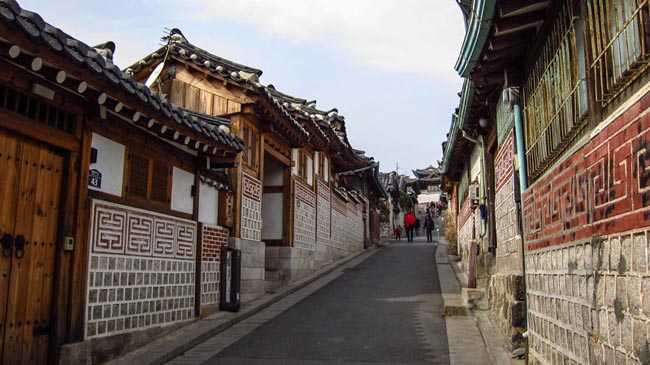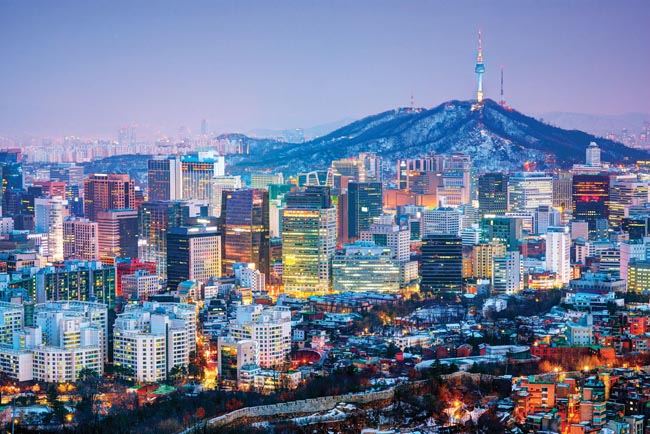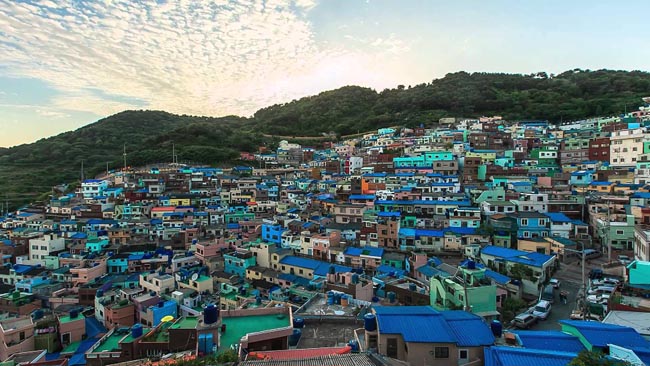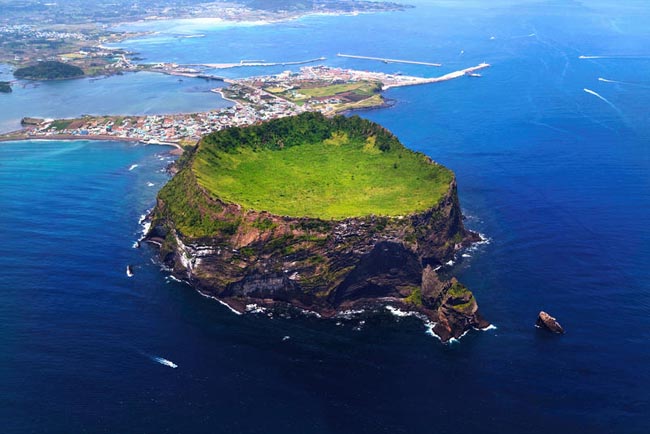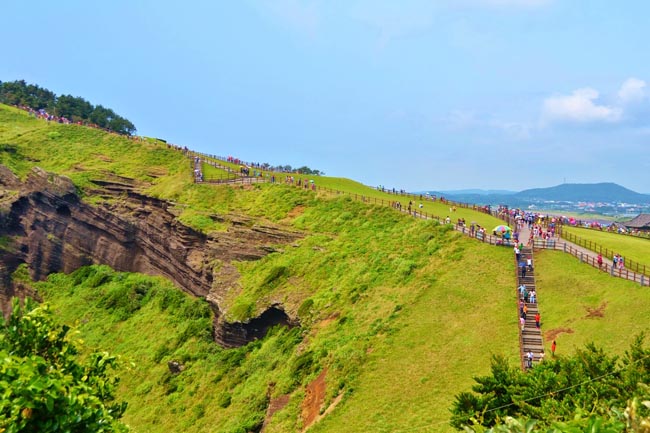This highlight-packed South Korea tour touches down in Seoul, one of the most exciting, dynamic and rapidly evolving cities in the world, and one that boasts historic and cultural attractions around every corner.
We visit the National Folk Museum, the beautiful Gyeongbokgung Palace and a Folk Village, which showcases Korean life as it was in the past through its centuries-old architectural style and the traditional lifestyles of its inhabitants.
An especially attractive inclusion is Jeju Island, a culturally-distinct and scenically stunning volcanic island famous for coastal scenery and laid-back atmosphere.
Prices below are per person, twin-sharing costs in US Dollars (USD). Pricing does not include airfare to/from the tour and any applicable taxes. For single supplement rates and taxes (if any), please refer to below Prices & Dates table. For general information on flights to/from the tour, click here.
Your Travel and Accommodation Arranged For You
Tips Included for Driver, Restaurant Staff, Local Guides
Authentic Local Experiences With Lots Of Inclusions.
Select a date below to reserve your spot:
Optional Single Supplement: $620 USD (number of singles limited).
Download Itinerary
Day 1 Arrive in Seoul
Arrive in Seoul/Incheon, South Korea and transfer to our hotel.
Seoul is a city of contrasts. In this rapidly evolving metropolis, the traditional exists with the modern in a state of harmony. For over 500 years the seat of Joseon Dynasty kings, Seoul is now the beating heart of modern Korea, the centre to which all else in the country is drawn.
Overnight in Seoul.
Included Meal(s): Dinner
Day 2 Seoul City Touring
This morning we start with a visit to Gyeongbokgung Palace, where we plan to arrive in time for the very colourful changing-of-the-guard ceremony.
Of all the tourist attractions in Seoul, the Joseon Dynasty Palaces and, particularly Gyeongbokgung Palace, are the most tangible link between modern Korea and its not-too-distant monarchical past. Not merely inert relics, they are symbols of a deep history and rich culture. Although substantially reduced in number, the remaining palace buildings provide a glimpse of traditional architecture and the overall organization of a palace grounds.
As part of our visit, we also include the National Folk Museum, contained within the palace. This excellent museum presents historical artifacts that were used in the daily lives of Korean people in the past. Through the displays, visitors can learn about the domestic and agricultural lifestyles, as well as Korea’s cultural beliefs.
After a break for lunch, we proceed to Jongmyo, a royal shrine dedicated to the performance of ancestral rites for the deceased kings and queens of the Joseon Dynasty. Being the place where the royal ancestral tablets are enshrined, Jongmyo's atmosphere is solemn and sacred rather than splendid like the royal palaces. The simple and elegant buildings of this shrine have faithfully kept their original forms since the 16th century.
We finish our day at Namsan Seoul Tower, built in 1969 as Korea's first integrated transmission tower beaming television and radio broadcasts across the capital. Since opening to the public in 1980, it has become a much-loved Seoul landmark. The tower's main attractions include multi-coloured digital art projected onto the tower at night, a digital observatory, a roof terrace, and a number of viewing platforms where visitors can enjoy the cityscape. 32 LCD screens recount the 600-year history of Seoul.
This evening we'll have our dinner at the top of the tower and enjoy a typical Korean meal and nighttime views of the city.
Overnight in Seoul.
Included Meal(s): Breakfast and Dinner
Not finding what you're looking for?
Our specialists can take away the stress and create a private custom tour tailored to your exact interests and budget.
Day 3 Seoul & The DMZ
This morning we hit the ground running with a full highlight-packed day.
After an early departure we travel along the Jayuro (Freedom Road) to Imjingak, the northernmost point bordering North Korea.* On the way, we will be able to view barbed wire fences and military guards on duty all the way along the river. At Imjingak, we visit the Mangbaedan Memorial ritual altar which was established in 1985 for those who were separated from their families or displaced from home during the Korean War. It is a symbolic spot used to hold traditional memorial services for ancestors or to pray for separated family members living in the North and for reunification of the country. We will see the Freedom Bridge, the very locale where 12,773 Korean War prisoners walked to freedom to South Korea in 1953.
We then board a tour bus that will take us to the 3rd infiltration tunnel dug up by North Koreans. On the 20-minute ride to the tunnel, we pass through the check points, military camps, and mine fields. Before going down to the tunnel, we will view a short video presentation and visit exhibition hall for information on the divided Koreas. A seven-minute tram ride (if available) or a walk down a steep access through a narrow and steep interception tunnel, leads us to the lower platform, a point where we are only 170 meters from the Military Demarcation Line.
Our next stop is the Dora Observatory where we can see the whole expanse of the Demilitarized Zone, North Korean propaganda village, Gijeong-dong, where the world's largest flag hangs on a 160 meter-tall flagpole, South Korea's northernmost village of Daeseong-dong and Panmunjom where the ceasefire that ended hostilities was signed.
We return to Seoul in time for a break for lunch in Insadong, a lively district known for it's vast array of restaurants, small museums, and shopping. Insadong was originally two towns whose names ended in the syllables "In" and "Sa". They were divided by a stream which ran along Insadong's current main street. Insadong began 500 years ago as an area of residence for government officials. Today Insadong has some of the tastiest food vendors in all of Seoul. One of the main attractions in the area is the ‘Kings Dessert’ or the ‘Dragons Beard Candy’, 16,000 strings of honey wrapped multiple times with a flavouring of either almond, peanut or chocolate on the inside. There are also gooey pancakes and spicy Korean dumplings to sample.
From here we proceed to the War Memorial of Korea, an excellent tie-in with what we experienced at the DMZ. This huge museum documents the history of the Korean War (1950–53) with documentary footage (with English commentary) of the main battles and events. Along with photos, maps and artefacts, the films give a fascinating insight into what the war was like. There's also plenty of military hardware outside – tanks, helicopters, missiles and planes, plus stirring war memorials.
* Due to an ever-changing security situation, our activities today may be altered, re-routed, or curtailed without notice.
Overnight in Seoul.
Included Meal(s): Breakfast and Dinner
Day 4 Seoul - Fly to Jeju Island
This morning we transfer to the airport for our short flight to Jeju Island.
Jeju Island, also known as the "Island of the Gods," is a popular vacation spot for Koreans and foreigners; indeed it remains the top honeymoon destination for Korean newlyweds. The island is known for beaches, rugged coastal scenery, volcanic geography, and a unique culture which stands in stark contrast to the mainland (and much of Asia) as being matriarchal. Stemming from this basis, and some odd tax reasons, the role of seafood gathering on the island has been dominated by women. As such, a common sight around Jeju's coastline is that of the "haenyo" or "woman diver", a figure that has become somewhat iconic of the island.
After our arrival we'll have a break for lunch, we visit Jeju Folk Village, a living museum showcasing traditional Jeju culture and lifestyle. The village is a collection of restored traditional Jeju houses, including thatched-roof homes and stone houses. Visitors can explore the village and learn about the daily lives of Jeju people in the past.
We also visit Jeju Stone Park, which showcases the cultural significance of stone in Jeju Province. The park features various stone structures, including a stone pagoda and traditional Jeju stone houses. It also includes a large garden themed around Jeju's mythology.
Overnight on Jeju Island.
Included Meal(s): Breakfast and Dinner
Day 5 Jeju Island Touring
Early this morning, we'll head to Sunrise Peak (Seongsan Ilchulbong) for a breathtaking view of this unique volcanic crater and its surroundings. Next we'll visit the Jeju Haenyeo Museum, dedicated to the island's remarkable female free divers. Finally, we'll explore Ilchul Land, a park featuring themed gardens, sculptures, and the intriguing Micheon Cave, a lava tube formed by volcanic activity. Jeju has an extensive system of lava tubes, natural conduits through which magma once flowed, now empty caves that are some of the largest in the world. The insides of the tube is adorned with multi-coloured carbonate decorations and innumerable cave formations commonly found in lava tubes. They include lava stalactites and lava stalagmites, lava columns, lava flowstone, lava helictites and lava blister, cave corals, benches, lava raft, lava bridges, lava shelves and striations.
Overnight on Jeju.
Included Meal(s): Breakfast and Dinner
Day 6 Jeju Island - Fly to Busan: City Touring
This morning we fly to Busan, South Korea's second largest city and largest seaport.
Busan is known for its beaches, hot springs, nature reserves, and events such as the city's renowned international film festival held each fall. Busan is a good destination for those seeking a more laid back atmosphere than Seoul. Located at the southern tip of the Korean Peninsula, Busan's important port gives the city an international flair, with sailors from around the world trooping through and a growing number of tourists.
On arrival we'll visit the Gamcheon Cultural Village (a UNESCO site), spread out in a panorama of endless rows of low-rise cubicle homes climbing up the steep hillsides, earning it the nickname "Santorini of the East." The cheerful blue, yellow and pink hues a delight to the eye. Narrow stone and concrete alleyways wind their way through the homes, yielding something new at every turn. The village used to house the city’s poorest people, but during the Korean War, refugees fled their homes for Busan, which was the only area which was free from fighting.
We'll head to the Jagalchi Fish Market for a break for lunch, followed by a visit to the impressive UN Cemetery.
Overnight in Busan.
Included Meal(s): Breakfast and Dinner
Day 7 Busan: Gyeongju Excursion
This morning we head out of the city to Gyeongju, located on Korea's southeast coast. This was the capital of the 1,000-year Silla dynasty, and is known for its extensive historical remains. We'll visit the 8th-century Bulguksa Temple featuring twin stone pagodas, a series of wooden staircases, and a large bronze Buddha.
Afer a break for lunch in Hwanglidan-gil we'll continue to Tumuli Park, which contains 23 of the over 200 royal tombs found in Gyeongju. At times, the sense of history, and of secrets buried along with the royals, is almost palpable in the quiet between the large grass-covered mounds.
We'll visit Cheomseongdae, the oldest astronomical observatory in all of Asia The 362 stones that make up the 27-level structure represent each day of the lunar year. Built during the reign of Shilla Queen Seon-deok, it was used for observing the stars in order to forecast the weather.
Our last stops include Gyeongju National Museum, largely devoted to relics of the Silla Kingdom; and Donggung Palace and Wolji Pond, once part of the palace complex of ancient Silla. Return to Busan.
PLEASE NOTE: owing to the length of the day and the probability of a busy trave day tomorrow, your Tour Leader may choose to include lunch today and leave dinner to yourselves this evening.
Overnight in Busan.
Included Meal(s): Breakfast and Dinner
Day 8 Departure from Busan
Departure from Busan.
BON VOYAGE!!
Included Meal(s): Breakfast
Inclusions
Breakfast and dinner (mostly at local restaurants) are included daily. All transport, accommodation, sightseeing and entrance fees for sites noted as 'visited' in the detailed itinerary. Gratuities for restaurant staff, porters, local guides. Airport transfers for land & air customers and for early arriving/late departing land & air customers who book their extra hotel nights through us.
Exclusions
International airfare to/from the tour.
Tour Leader gratuities.
Lunches, drinks, personal items (phone, laundry, etc), domestic and international (if applicable) air taxes, and any excursions referenced as 'optional'.
Airport transfers for Land Only customers.
Optional trip cancellation insurance.
Our post-reservation trip notes offer further guidance on shopping, not included meals.
Seasonality and Weather
Spring can expect warm temperatures with moderate humidity. March/April dates can expect daytime high temperatures of about 17-21C (63-68 F), with chilly mornings and evenings.
Our fall departure coincides with the beginning of the drier time of year and cool temperatures with highs ranging 15-18 C (60-66 F).
Rain showers can occur at any time, though their likelihood decreases the later we get into the fall. Our fall date is set to coincide with autumn leaf colour, though this varies from year to year.
Transport and Travel Conditions
We rate this tour difficulty 'Level 2', which relates mostly to some full days of travel, uneven surfaces, and plenty of time on your feet. Our pace is leisurely, but we have some full days of activities and have multiple walking tours of sites for several hours. We also have short walks to/from dinner at the end of our days. We do, however, time the tour for times when heat is not a factor. Our accommodations are comfortable and there will likely be baggage handling assistance to/from your room.
There is also a very strong culinary element to this trip. Breakfasts feature Asian as well as Western items, but our dinners out at local restaurants will feature a wide range of local specialties. Eating is very much a cultural experience in this part of the world, and this aspect of our program is an integral part of the overall experience. Though individual tastes and requirements will be taken into account by your leader who will be organizing our evening meals on-the-go, if you are strictly a meat-and-potatoes person, or a strict vegan/gluten-free etc, you may find your preferences significantly challenged on this tour.
Am I suitable for this tour? Please refer to our self-assessment form.
Activity Level: 1
No particular physical activity is involved other than town/city walks and short walks to dinners and sites of interest, some of which are large.
To learn more about the Activity levels, please visit our tour styles page.
Accommodation
All hotels are centrally-located, Western style, air-conditioned, 3 & 4-star standard with private bath facilities.
Please click on the "Map & Hotels" tab elsewhere on this page for more information.
Staff and Support
Tour Leader throughout, local guides at various locations.
Group Size
Maximum 18 plus Tour Leader
Tour Extensions
This tour is part of a series that can be upgraded to make for a longer trip. For more options, please refer to tour code/s:
Tour Overview Countries Visited: 2 Acivity Level: 2 Tour Style: Cultural
From the bustling neon-lit streets of Taipei to the serene temples of ancient Tainan, this tour offers a captivating contrast of old and new. Explore the modern marvels of Seoul, including the iconic Namsan Seoul Tower, and journey to the historic DMZ. Then, unwind on the stunning island of Jeju, a natural wonder with breathtaking landscapes.
Tour Overview Countries Visited: 2 Acivity Level: 2 Tour Style: Cultural
This highly rewarding 20-day South Korea & Japan By Rail tour kicks off in fine style in the ancient city of Seoul, Korea, which is today one of the most populous and dynamic cities in the world.
Our city tour encompasses the presidential residence, the palaces and the museum, and we glean an even better understanding of the history of the city with a visit to the Korean Folk Village, wherein inhabitants lead traditional lifestyles and practice traditional customs.
Heading to Japan, we first stop off in Tokyo to see the largest wholesale market in the world, the Imperial Palace and the finest collection of Japanese art in the entire country.
Aboard the 'bullet train' we make headway through beautiful countryside to the mountainous Hakone region, where we see castle towns and national parks and take a funicular to marvel at magnificent views farther up the mountainside.
In the Hida area, we find a people whose long isolation due to geographic conditions has resulted in an evolution of lifestyle and culture unlike any other region in the country.
Kyoto and Hiroshima round off the Japan leg of our adventure and bring our tour to a climactic close.
Tour Overview Countries Visited: 2 Acivity Level: 2 Tour Style: Cultural
For almost an entire month, our South Korea & Japan By Rail tour journeys through the myriad landscapes and fascinating cultures of South Korea and Japan, leaving no stone unturned in our mission to glean an understanding of the sociological and ethnographic inner workings of these two unforgettable destinations.
In Seoul, South Korea, our city tour takes us to the National Folk Museum and a couple of the beautiful Joseon Dynasty palaces and then we head off the beaten path to spend time in a traditional village, where buildings, dress and lifestyles are throwbacks to a long distant past.
Jetting over to Japan, we begin our next leg of the tour exploring the bustling marketplaces, palaces and beautiful gardens of the capital city, Tokyo.
Truly an assault on the senses, Tokyo is a destination that is certain to leave a lasting impression.
The 'bullet train' whisks us off to the Hakone region, a beautifully picturesque area of deep glens and ravines and as we venture into the Hida region, we find a land and people whose nature and lifestyles have remained unchanged for centuries.
Our tour of Kyoto yields the opportunity to see Sanjusangendo Temple and the 1,001 life-size statues of the Buddhist teacher Kannon and in Hiroshima, we experience the sights and sounds of a bustling metropolis that rose from the ashes of the devastation of five centuries ago to become one of Japan's most emerging cities.
We tour centuries-old castle towns, see one of the world's most active volcanoes (from a safe distance), peer into one of the world's largest calderas, and saunter the streets of Nagasaki - one of the country's most rewarding and exotic locations.
Tour Overview Countries Visited: 3 Acivity Level: 2 Tour Style: Cultural
Embark on a captivating journey through the vibrant cities and serene landscapes of East Asia. Discover the bustling metropolis of Taipei, the ancient charm of Tainan, and the dynamic culture of Seoul. Experience the tranquility of Jeju Island, the historic sites of Kyoto, and the poignant memorials of Hiroshima. From the modern marvels of Tokyo to the traditional beauty of Kamakura and Hakone, this unforgettable adventure offers a unique blend of history, culture, and natural beauty.
Tour Overview Countries Visited: 3 Acivity Level: 2 Tour Style: Cultural
Embark on a captivating journey through the diverse landscapes and rich history of East Asia. Discover the vibrant city of Taipei, the ancient charm of Tainan, and the dynamic culture of Seoul. Immerse yourself in the serene beauty of Jeju Island, the historic sites of Kyoto, and the poignant memorials of Hiroshima. From the volcanic wonders of Aso-Kuju National Park to the cultural treasures of Nagasaki, this unforgettable adventure offers a unique blend of natural beauty, historical significance, and modern marvels.
Tourism Partners

Regions visited: Far East
Countries visited: South Korea
*The red tour trail on the map does not represent the actual travel path.
The following is a list of sample hotels at some locations included on this tour. The hotels shown here are meant to provide a general sense of the standard of hotel we usually aim for; they are not necessarily confirmed for your chosen departure.













